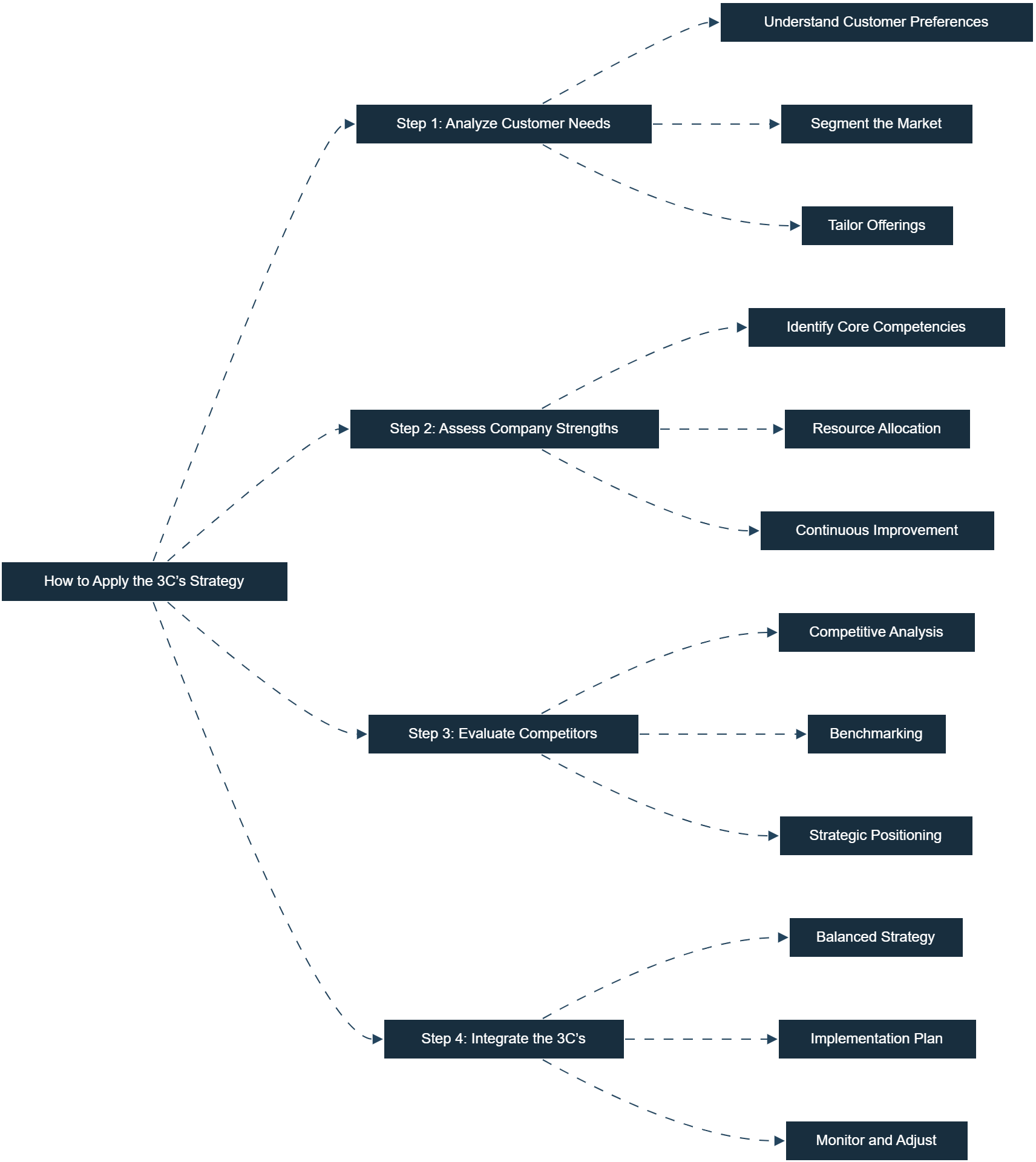The 3C’s Strategy, developed by Kenichi Ohmae, is a strategic framework that focuses on three critical factors for business success: Customer, Company, and Competitors.
This model emphasizes the need for a balanced approach to these three elements to create a competitive advantage and achieve long-term success.
By understanding and integrating the 3C’s into business strategies, organizations can better align their operations, address market demands, and outperform their competitors.
What is the 3C’s Strategy?
The 3C’s Strategy is a business model that centers around three key components:
Customer: Understanding and meeting customer needs and preferences.
Company: Leveraging the company’s strengths and resources.
Competitors: Analyzing and positioning against competitors in the market.
These three components are interrelated, and a successful strategy requires a balance among them.
Why is the 3C’s Strategy Important?
The 3C’s Strategy is crucial for several reasons:
Customer Focus: It ensures that customer needs and preferences are at the forefront of business decisions.
Internal Strengths: It leverages the company’s internal strengths and resources effectively.
Competitive Advantage: It helps businesses understand and position themselves against competitors.
Balanced Approach: It promotes a balanced approach, considering all critical factors for business success.
Strategic Alignment: It aligns business strategies with market demands and competitive dynamics.
How to Apply the 3C’s Strategy

Step 1: Analyze Customer Needs
Understand Customer Preferences: Conduct market research to understand customer needs, preferences, and behaviors.
Segment the Market: Divide the market into segments based on customer characteristics and preferences.
Tailor Offerings: Develop products and services that meet the specific needs of each segment.
Step 2: Assess Company Strengths
Identify Core Competencies: Determine the company’s core competencies and unique strengths.
Resource Allocation: Allocate resources to areas where the company can leverage its strengths effectively.
Continuous Improvement: Continuously improve processes, products, and services to maintain a competitive edge.
Step 3: Evaluate Competitors
Competitive Analysis: Analyze competitors’ strengths, weaknesses, strategies, and market positions.
Benchmarking: Compare the company’s performance against key competitors to identify gaps and opportunities.
Strategic Positioning: Develop strategies to position the company effectively against competitors.
Step 4: Integrate the 3C’s
Balanced Strategy: Create a balanced strategy that considers customer needs, leverages company strengths, and positions against competitors.
Implementation Plan: Develop a detailed implementation plan, outlining actions, timelines, and responsibilities.
Monitor and Adjust: Regularly monitor the strategy’s effectiveness and make necessary adjustments.
When to Use the 3C’s Strategy
Strategic Planning
Use the 3C’s Strategy during strategic planning to ensure all critical factors are considered.

Market Entry
Apply the framework when entering new markets to understand customer needs, assess company strengths, and evaluate competitors.
Product Development
Use it to guide product development by aligning offerings with customer needs and market demands.
Competitive Analysis
Employ the 3C’s Strategy to conduct thorough competitive analysis and develop strategies to outperform competitors.
Performance Improvement
Utilize the model to identify areas for performance improvement and align business operations with strategic goals.
In-Depth Look at Each Component
Customer
Definition: The needs, preferences, and behaviors of the target market.
Key Questions: Who are our customers? What do they need and value? How can we meet their needs better than competitors?
Company
Definition: The internal strengths, resources, and capabilities of the organization.
Key Questions: What are our core competencies? How can we leverage our strengths? What resources do we have at our disposal?
Competitors
Definition: The other players in the market and their strategies, strengths, and weaknesses.
Key Questions: Who are our main competitors? What are their strengths and weaknesses? How can we differentiate ourselves?
Benefits of the 3C’s Strategy
Customer-Centric Approach: Ensures customer needs are central to business strategies.
Leveraged Strengths: Helps businesses leverage their internal strengths effectively.
Competitive Positioning: Enables better positioning against competitors.
Balanced Focus: Promotes a balanced focus on all critical factors for business success.
Strategic Clarity: Provides clear direction and alignment for strategic initiatives.
Challenges and Considerations
Complexity: Implementing a balanced approach can be complex and resource-intensive.
Data-Driven: Requires accurate and comprehensive data for effective analysis.
Continuous Adaptation: Needs regular monitoring and adaptation to changing market conditions.
Integration: Ensuring seamless integration of customer, company, and competitor insights can be challenging.
Conclusion
The 3C’s Strategy is a powerful framework that helps businesses create a balanced and effective approach to strategic planning and execution.
By focusing on customers, leveraging company strengths, and positioning against competitors, organizations can achieve sustainable competitive advantage and long-term success.
Whether used for strategic planning, market entry, product development, or competitive analysis, the 3C’s Strategy provides valuable insights and a structured approach to navigating the complexities of the business environment.